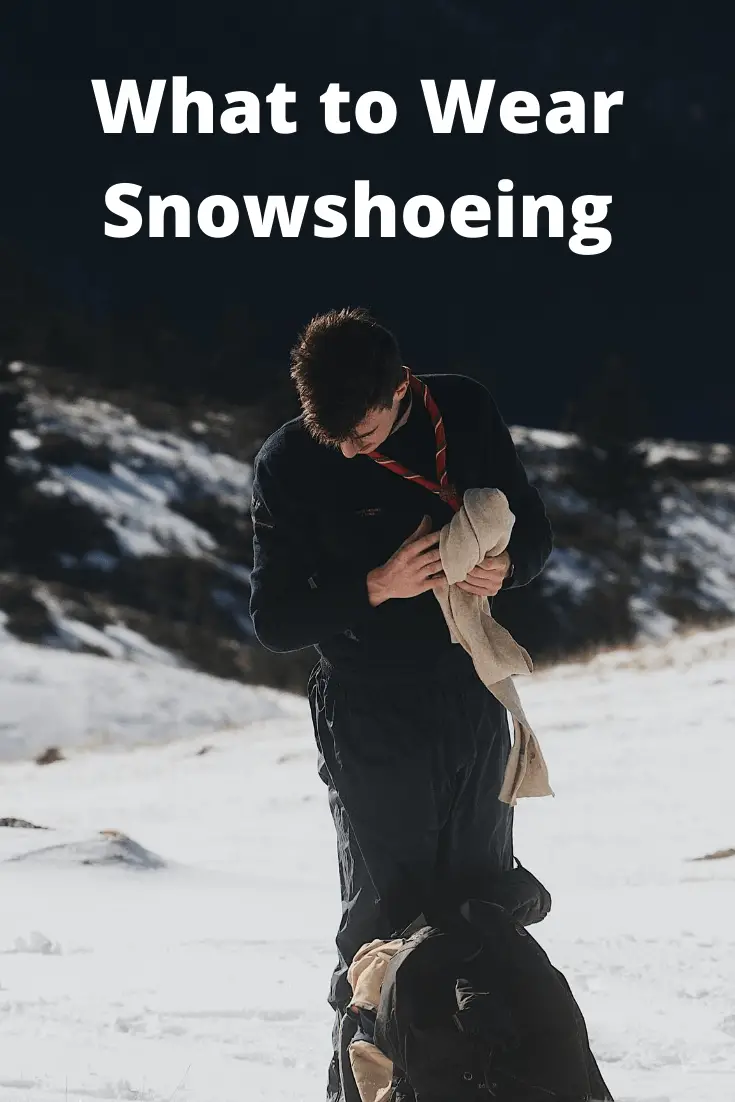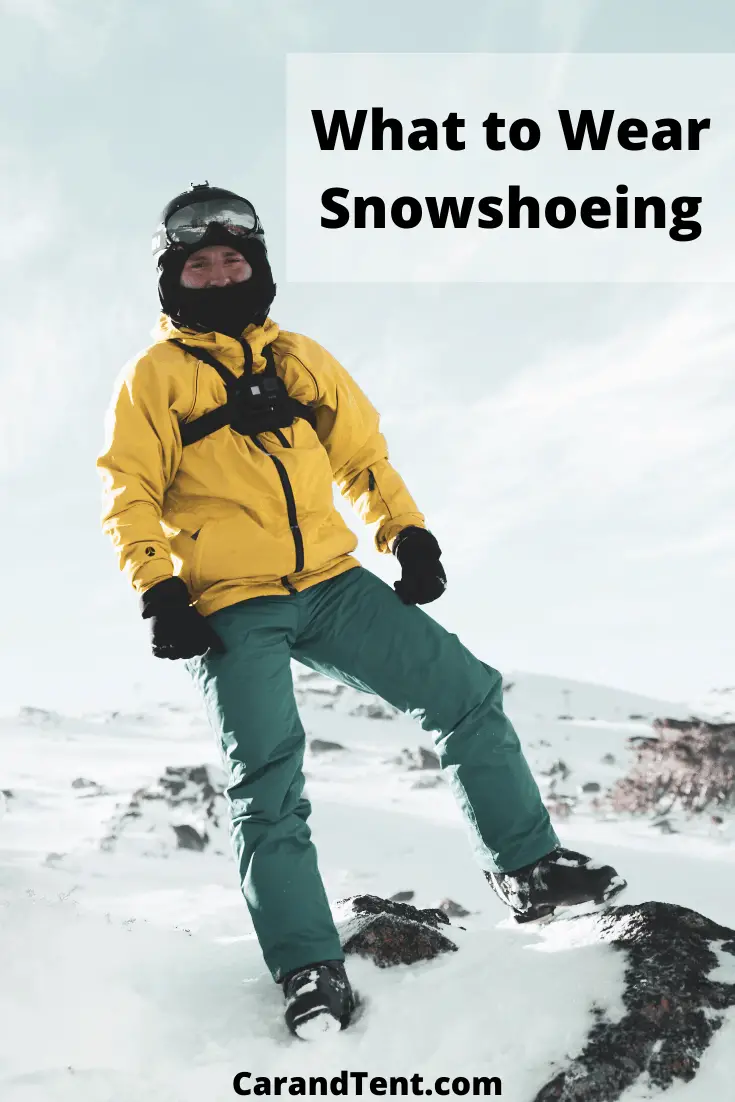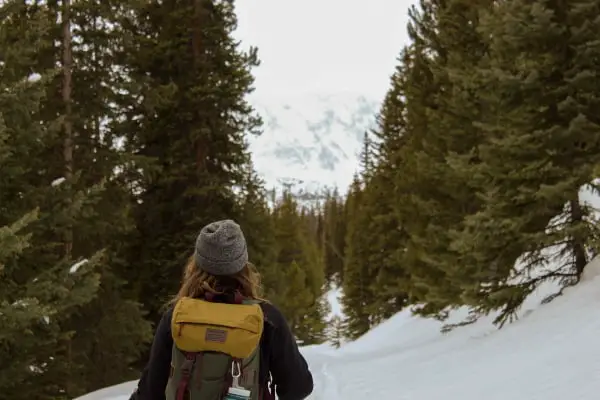
There is an extraordinary amount of gear and clothing that you can buy to go snowshoeing with. But how much of this gear do you actually need? What kind of clothes do you really have to wear when snowshoeing? In this post, I’ll tell you exactly what you need to wear when snowshoeing.
So, what to wear snowshoeing? A snowshoer should wear a base layer with moisture-wicking properties against their skin. On top of this, they should have multiple layers that can easily be taken off and put back on again.
Let’s dig into this a little further.
Table of Contents
The Base Layer
Your base layer is made up of long underwear and it should fit close to your skin. The reason for this is that the moisture-wicking properties of your base layer will not be able to do their job if the base layer isn’t close to your skin.
Of course, you’ll want to make sure you actually get a base layer that has moisture-wicking properties as well. These can come in the form of natural materials like merino wool or in synthetic fibers like polypropylene.
I was issued polypropylene in the army so I’m more comfortable with that material than the others but some people prefer the feel of merino wool. The main thing is to make sure you don’t wear an all-cotton garment as you’ll end up sweating and the cotton will hold the sweat against your skin.
Should you wear underwear under your base layer?
Personally, I always wear a pair of boxer-briefs underneath my base layer. It might sound silly to wear underwear underneath of underwear but I feel like it’s more sanitary and it doesn’t make me any less comfortable. A lot of other people feel the same way and they wouldn’t even consider going commando underneath their base layer.
Still, I’ve heard from other people who think wearing underwear under their base layer is ludicrous. They think it’s uncomfortable and can’t understand why others might do it.
What this means is that you’ll have to decide for yourself which feels best to you. The main thing to note is that if you do decide to wear underwear, it should have moisture-wicking properties as well. Otherwise, you’ll end up being wet and sweaty in one of the most uncomfortable places imaginable, which could really bring down your experience.
Pants
You can wear as many layers over your base layer as you want, but I’ve never found the need to wear anything other than pants over them. The key to choosing good pants for snowshoeing is choosing pants that protect you against wind and moisture while providing an additional layer of insulation. Once again, you’ll want to stay away from cotton.
I’ve gotten away with wearing old jeans on short snowshoe trips near home but I’ve always regretted wearing them. Denim is just cotton and it soaks up water fast and dries out slowly so you’re better off going with a pair of pants that are a little more robust.
In extreme cold-weather conditions, you may want to wear ski pants or pants that are lined with fleece. However, if you’re snowshoeing in milder temperatures, you’ll be better off in a pair of 3-season hiking pants. These pants will usually be made from a nylon blend and they’ll shed snow easily without weighing you down. Remember, overdressing can be just as bad as underdressing as excessive sweat will end up quickly dropping your body temperature. If you’re unsure, just add additional layers that you can take off along the way.
Jackets
There are a lot of cold-weather jackets that will work for snowshoeing. However, I’ve always found that your best bet is to choose a lighter jacket and to then add a bunch of layers underneath of that. I prefer layers that have zippers on them so that I can quickly take them off and stuff them into my backpack whenever I get too hot. If I start to get cold again later, I’ll simply pull a layer out of my backpack and pop it back on.
With this knowledge in mind, choose a jacket that will provide protection against the wind and the rain. Nylon outers, fleece, and wool can all work well and if you can’t provide for protection against the rain with the jackets you have, feel free to bring along a raincoat or poncho with you. Raincoats that fold up so that they can be packed in a backpack are a great investment but even a dollar store poncho will work in a pinch.
Snow Goggles
Unless you go snowshoeing on a particularly cloudy day, you’ll want to take some eye protection with you. Snow blindness is real and it can quickly ruin your weekend and even lead to long-term eye damage.
Sunglasses can help to protect you against snow blindness and they’ll even provide a bit of protection from the wind as well. This being said, I prefer to wear snow goggles. My eyes get really dry in the winter and if I don’t wear goggles, they’ll end up tearing up throughout the entire trip.
Even if I didn’t have dry eyes, I’d probably still wear a nice pair of snow goggles. Snow goggles stay on your face a lot easier than sunglasses and because they have a strap, it’s a lot less likely that you’ll lose them.
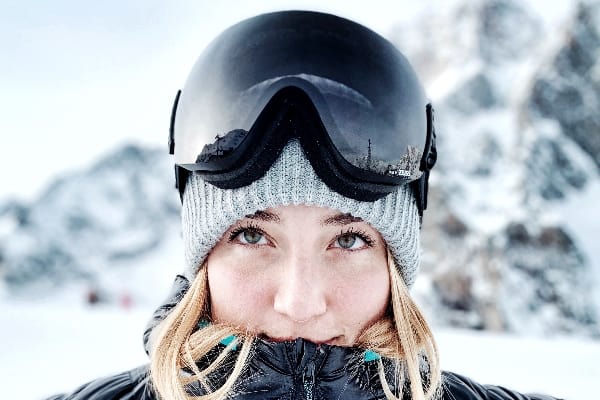
You can buy a good pair of snow goggles that offer full UV protection for as little as $20.00 or $30.00. These goggles will fit well against your face and they won’t fog up like a standard pair of sunglasses would. Most goggles will also let you put lenses in them which is perfect for people who would normally wear prescription glasses.
Hats
You’ll definitely want to wear something over your head. On warmer days, this can be as simple as a nice wool hat and a scarf. Alternatively, you could opt to wear a jacket with a tight-fitting hood.
For colder snowshoeing trips, you may want to opt for a balaclava. A balaclava will provide everything from the neck up with protection with the exception of your eyes. You’ll be wearing snow goggles over them, so you won’t have to worry about your eyes either. For the most part, I like wearing balaclavas but sometimes they can be a little too warm. Because of this, even if I’m wearing a balaclava, I’ll still pack a hat and a scarf that I can switch to during my trip.
In case you haven’t considered this, don’t wear your balaclava into a store – they might think you’re robbing the place. This is especially true if you’re traveling through a city with your gear on. In fact, don’t put your balaclava on until you’re in the parking lot of your destination. Putting it on too early will just lead to you overheating before you even get started.
Gloves
Gloves and mittens both work well for snowshoeing. Mittens will keep your hands warmer but gloves will give you a little more flexibility when moving stuff to and from your backpack.
I probably sound like a broken record at this point, but don’t wear cotton gloves. Cotton gloves make great driving gloves but they don’t hold up very well to the outdoors. Again, this is because they’ll soak up water like a sponge and they won’t dry out very quickly either.
Instead, you may want to opt for a warm Gortex glove. These gloves can be a little pricey but in my opinion, they’re more than worth it.
Alternatively, you could wear a glove system like the military used to use. These gloves consisted of a pair of wool gloves that were then used inside of a pair of leather gloves. The wool helped keep your hands warm while the leather kept your hands dry and added an additional layer of warmth. Personally, I hated these gloves, but they are a cheap and effective alternative to some of the more expensive gloves on the market today.
Gaiters
Gaiters are great for keeping snow and ice out of your boots and off of your lower legs. Some people use them for hiking and skiing but they’re especially useful for snowshoers. Oftentimes, while snowshoeing you’ll find that you sink lower into the snow than you might have hoped. When you do, your gaiters will ensure that your feet don’t end up wetter than you would have hoped.
A gaiter will come in a few different heights but for snowshoeing, the taller the gaiter, the better. A pair of knee-high gaiters should ensure that you have a nice waterproof barrier over your boots.
When buying gaiters, make sure you get the right size. Gaiters generally sell by shoe size and they’ll come in a range of sizes like socks. For example, a pair of gaiters might be sold that fit men’s sizes 8 to 11. If you wear size 10 boots, these will be the gaiter size you buy.
Boots
Unlike hiking boots, snowshoe boots don’t have to have much traction. Your boots are going to sit comfortably in your snowshoes and they’ll provide the traction you need to move through the snow. For this reason, I always wear an old pair of hiking boots. It gives my worn-out hiking boots a second use and an excuse not to throw them away.
When choosing boots to wear for snowshoeing, choose boots that are waterproof, lightweight, and warm. I’m a big fan of my old Gortex boots and I wear them every time I go out without any trouble. I wouldn’t wear them alone on ice and snow, but with a snowshoe strapped onto them, they work just fine.
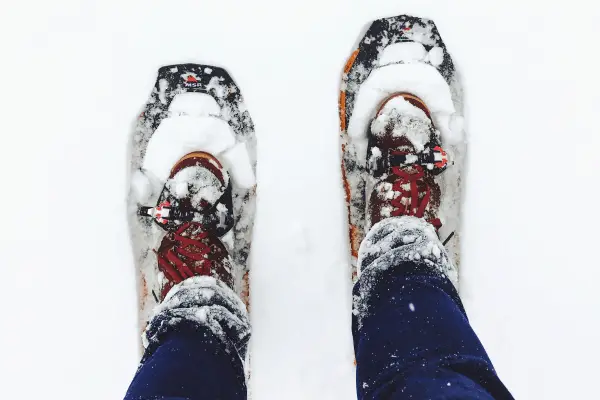
Backpack
A backpacker snowshoeing on an overnight trip should obviously bring a good backpack with them. However, I’d suggest that everyone else bring one too. This is true when you plan on hiking throughout the entire day and it’s true even if you only plan on doing a few miles.
The main reason for this is that the backpack will allow you to bring some emergency supplies with you. Spraining your ankle and getting stuck out on a hiking trail when it’s freezing outside is much different than getting stuck out on the trail when it’s 75 degrees outside.
I generally pack with me some extra water, food, and some items to keep me warm. Hand warmers, extra gloves, extra hats, and extra socks can all work wonders when it’s freezing cold outside. You can also use the backpack to hold some of the additional layers you shed when you get warm so it’s useful no matter what happens out on the trail.
Additional Thoughts
It’s never a bad idea to wear brightly colored clothing. Oranges, yellows, and reds are easy to spot in the snow and they could end up saving your life one day. Fall and hit your head and passers-by are much more likely to see you and save you when you’re wearing red versus when you’re wearing white or black.

